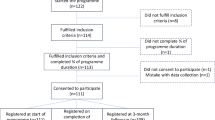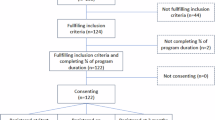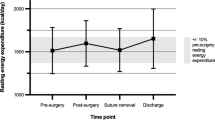Abstract
Objective:
To assess the effect from maximal bench press strength training (MST) on wheelchair propulsion work economy (WE).
Study design:
Pretest–posttest case–control group design.
Setting:
St Olavs Hospital, Trondheim, Norway.
Methods:
Seventeen male individuals with spinal cord injury (SCI) paraplegia were allocated to either MST bench press (n=11) or the control group (CG) (n=7). The MST group trained bench press three times per week, for 6 weeks, starting at 85–95% of their pretest bench press one-repetition maximum (1RM). For calculation of WE during wheelchair propulsion, oxygen uptake (VO2) measurements were collected during wheelchair ergometry (WCE) at submaximal workload of 50 W. Similarly, peak oxygen uptake (VO2peak) and peak power output (W) were measured during WCE.
Results:
Individuals in the MST regimen significantly improved WE compared with the CG by 17.3 % (mean between-group differences: 95% confidence interval) of 2.63 ml kg−1 min−1: (−4.34, −0.91) (P=0.007). Between pretest and posttest, the increase in bench press 1RM was by 17% higher in the MST group compared with the CG. At peak testing, the MST group generated significantly higher peak power compared with the CG. All other physiological variables were comparable within and between groups.
Conclusions:
A 6-week MST bench press regimen significantly improved WE during wheelchair propulsion at 50 W workload. These preliminary data support a possible beneficial role for MST to reduce the energy cost of wheelchair propulsion for SCI individuals.
Similar content being viewed by others
Log in or create a free account to read this content
Gain free access to this article, as well as selected content from this journal and more on nature.com
or
References
Bergh U, Kanstrup IL, Ekblom B . Maximal oxygen uptake during exercise with various combinations of arm and leg work. J Appl Physiol 1976; 41: 191–196.
Price M . Energy expenditure and metabolism during exercise in persons with a spinal cord injury. Sports Med 2010; 40: 681–696.
Hoff J, Gran A, Helgerud J . Maximal strength training improves aerobic endurance performance. Scand J Med Sci Sports 2002; 12: 288–295.
Aagaard P, Simonsen EB, Andersen JL, Magnusson P, Dyhre-Poulsen P . Increased rate of force development and neural drive of human skeletal muscle following resistance training. J Appl Physiol (1985) 2002; 93: 1318–1326.
Heggelund J, Fimland MS, Helgerud J, Hoff J . Maximal strength training improves work economy, rate of force development and maximal strength more than conventional strength training. Eur J Appl Physiol 2013; 113: 1565–1573.
Barrett-O'Keefe Z, Helgerud J, Wagner PD, Richardson RS . Maximal strength training and increased work efficiency: contribution from the trained muscle bed. J Appl Physiol (1985) 2012; 113: 1846–1851.
Hoff J, Tjønna AE, Steinshamn S, Høydal M, Richardson RS, Helgerud J et al. Maximal strength training of the legs in COPD: a therapy for mechanical inefficiency. Med Sci Sports Exerc 2007; 39: 220–226.
Turbanski S, Schmidtbleicher D . Effects of heavy resistance training on strength and power in upper extremities in wheelchair athletes. J Strength Cond Res 2010; 24: 8–16.
Pelletier CA, Totosy de Zepetnek JO, MacDonald MJ, Hicks AL . A 16-week randomized controlled trial evaluating the physical activity guidelines for adults with spinal cord injury. Spinal Cord 2015; 53: 363–367.
Hicks AL, Martin KA, Ditor DS, Latimer AE, Craven C, Bugaresti J et al. Long-term exercise training in persons with spinal cord injury: effects on strength, arm ergometry performance and psychological well-being. Spinal Cord 2003; 41: 34–43.
Mooren F. Encyclopedia of Exercise Medicine in Health and Disease. Springer: Berlin, Germany, 2012..
Devillard X, Calmels P, Sauvignet B, Belli A, Denis C, Simard C et al. Validation of a new ergometer adapted to all types of manual wheelchair. Eur J Appl Physiol 2001; 85: 479–485.
Behm DG, Sale DG . Velocity specificity of resistance training. Sports Med 1993; 15: 374–388.
Almasbakk B, Hoff J . Coordination, the determinant of velocity specificity? J Appl Physiol 1996; 81: 2046–2052.
Fimland MS, Helgerud J, Gruber M, Leivseth G, Hoff J . Functional maximal strength training induces neural transfer to single-joint tasks. Eur J Appl Physiol 2009; 107: 21–29.
Shephard RJ, Bouhlel E, Vandewalle H, Monod H . Muscle mass as a factor limiting physical work. J Appl Physiol 1988; 64: 1472–1479.
Haisma JA, Post MW, van der Woude LH, Stam HJ, Bergen MP, Sluis TA et al. Functional independence and health-related functional status following spinal cord injury: a prospective study of the association with physical capacity. J Rehabil Med 2008; 40: 812–818.
Jacobs PL, Nash MS, Rusinowski JW . Circuit training provides cardiorespiratory and strength benefits in persons with paraplegia. Med Sci Sports Exerc 2001; 33: 711–717.
Author information
Authors and Affiliations
Corresponding author
Ethics declarations
Competing interests
The authors declare no conflict of interest.
Rights and permissions
About this article
Cite this article
Tørhaug, T., Brurok, B., Hoff, J. et al. The effect from maximal bench press strength training on work economy during wheelchair propulsion in men with spinal cord injury. Spinal Cord 54, 838–842 (2016). https://doi.org/10.1038/sc.2016.27
Received:
Revised:
Accepted:
Published:
Issue date:
DOI: https://doi.org/10.1038/sc.2016.27



